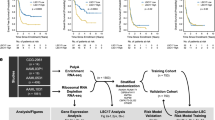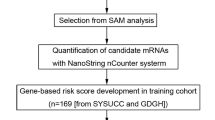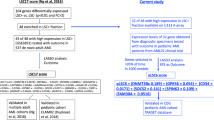Abstract
Gene expression profiling is a promising tool for classification of pediatric acute lymphoblastic leukemia (ALL). We analyzed the gene expression at the time of diagnosis for 45 Danish children with ALL. The prediction of 5-year event-free survival or relapse after treatment by NOPHO-ALL92 or 2000 protocols resulted in a classification accuracy of 78% and a Matthew's correlation coefficient of 0.59 independently of immunophenotypes. The sensitivity and specificity for prediction of relapse were 87% and 69% respectively. Prediction of high vs low levels of the minimal residual disease (MRD) on day 29 (⩾0.1% or ⩽0.01%) resulted in an accuracy of 100% for precursor-B samples. The classification accuracy of precursor-B- vs T-lineage immunophenotypes was 100% even in samples with as little as 10% leukemic blast cells, and the immunophenotype classifier constructed in this study was able to classify 131 of 132 samples from a previous study correctly. Our study indicates that the Affymetrix Focus Array GeneChip may be used without loss of classification performance compared to previous studies using the far more extensive U133A+B GeneChip set. Further studies should focus on prediction of MRD, as this prediction would relate strongly to long-term outcome and could thus determine the intensity of induction therapy.
This is a preview of subscription content, access via your institution
Access options
Subscribe to this journal
Receive 12 print issues and online access
$259.00 per year
only $21.58 per issue
Buy this article
- Purchase on Springer Link
- Instant access to full article PDF
Prices may be subject to local taxes which are calculated during checkout



Similar content being viewed by others
References
Hjalgrim LL, Rostgaard K, Schmiegelow K, Soderhall S, Kolmannskog S, Vettenranta K et al. Age- and sex-specific incidence of childhood leukemia by immunophenotype in the Nordic countries. J Natl Cancer Inst 2003; 95: 1539–1544.
Gustafsson G, Schmiegelow K, Forestier E, Clausen N, Glomstein A, Jonmundsson G et al. Improving outcome through two decades in childhood ALL in the Nordic countries: the impact of high-dose methotrexate in the reduction of CNS irradiation. Nordic Society of Pediatric Haematology and Oncology (NOPHO). Leukemia 2000; 14: 2267–2275.
Pui CH, Relling MV, Campana D, Evans WE . Childhood acute lymphoblastic leukemia. Rev Clin Exp Hematol 2002; 6: 161–180, 200–202.
Ross ME, Zhou X, Song G, Shurtleff SA, Girtman K, Williams WK et al. Classification of pediatric acute lymphoblastic leukemia by gene expression profiling. Blood 2003; 102: 2951–2959.
Golub TR, Slonim DK, Tamayo P, Huard C, Gaasenbeek M, Mesirov JP et al. Molecular classification of cancer: class discovery and class prediction by gene expression monitoring. Science 1999; 286: 531–537.
Yeoh EJ, Ross ME, Shurtleff SA, Williams WK, Patel D, Mahfouz R et al. Classification, subtype discovery, and prediction of outcome in pediatric acute lymphoblastic leukemia by gene expression profiling. Cancer Cell 2002; 1: 133–134.
Nyvold C, Madsen HO, Ryder LP, Seyfarth J, Svejgaard A, Clausen N, et al., Nordic Society for Pediatric Hematology and Oncology. Precise quantification of minimal residual disease at day 29 allows identification of children with acute lymphoblastic leukemia and an excellent outcome. Blood 2002; 99: 1253–1258.
Ihaka R, Gentleman R . R: a language for data analysis and graphics. J Comp Graph Stat 1996; 5: 299–314.
Workman C, Jensen LJ, Jarmer H, Berka R, Gautier L, Nielsen HB et al. A new non-linear normalization method for reducing variability in DNA microarray experiments. Genome Biol 2002; 3: 1–16.
Li C, Wong WH . Model-based analysis of oligonucleotide arrays: expression index computation and outlier detection. Proc Natl Acad Sci USA 2001; 98: 31–36.
Li C, Wong WH . Model-based analysis of oligonucleotide arrays: model validation, design issues and standard error application. Genome Biol 2001; 2: 1–11.
Irizarry RA, Hobbs B, Collin F, Beazer-Barclay YD, Antonellis KJ, Scherf U et al. Exploration, normalization, and summaries of high density oligonucleotide array probe level data. Biostatistics 2003; 4: 249–264.
Knudsen S (ed). A Biologist's Guide to Analysis of DNA Microarray Data. New York: Wiley-Interscience, 2002.
Dudoit S, Fridlyand J . Introduction to classification in microarrray experiments. In: Berrar DP, Dubitzky W, Granzow M (eds). A Practical Approach to Microarray Data Analysis. Dordrecht: Kluwer Academic Publishers, 2003.
Dudoit S, Fridlyand J . Classification in microarray experiments. In: Speed T (ed). Statistical Analysis of Gene Expression Microarray Data, Interdisciplinary Statistics. Boca Raton, FL: CRC Press, 2003.
Dyrskjøt L, Thykjaer T, Kruhoffer M, Jensen JL, Marcussen N, Hamilton-Dutoit S et al. Identifying distinct classes of bladder carcinoma using microarrays. Nat Genet 2003; 33: 90–96.
Tibshirani R, Hastie T, Narasimhan B, Chu G . Diagnosis of multiple cancer types by shrunken centroids of gene expression. Proc Natl Acad Sci USA 2002; 99: 6567–6572.
Conradsen K (ed). Diskriminantanalyse. In: En introduktion til statistik, Bind 2, 5th edn. Lyngby: IMM, 2002, pp 309–342.
Cortes C, Vapnik V . Support-vector network. Mach Learn 1995; 20: 1–25.
Matthews BW . Comparison of the predicted and observed secondary structure of T4 phage lysozyme. Biochim Biophys Acta 1975; 405: 442–451.
Acknowledgements
We thank staff members from the Section of Clinical Hematology and Oncology, Rigshospitalet, laboratory technicians from the Department of Clinical Immunology, Rigshospitalet and people at Center for Biological Sequence Analysis, Technical University of Denmark for their assistance. This work was supported financially by Knud Veilskov's Foundation, Ellen and Aage Fausbølls Health Foundation of 1975, Holger and Inez Petersens Foundation, Gangsted Foundation, Vilhelm Pedersens Foundation, Danish National Research Foundation, Danish Biotechnology Instrument Centre, Danish Center for Scientific Computing, Novo Nordisk, Novozymes, Carlsberg Foundation, The Danish Cancer Society (Grant Nos. 99 144 10 9132, 94-100-28, and 96-100-07), The Danish Cancer League, The Edith & Søren Kiilerich Hansen Family Foundation, The Emil and Inger Hertz Foundation, The Kornerup Foundation, The Lundbeck Foundation, The Medical Research Council in Denmark (Grant No. 9401011), and The Queen Louise's Children's Hospital Foundation.
Author information
Authors and Affiliations
Corresponding author
Rights and permissions
About this article
Cite this article
Willenbrock, H., Juncker, A., Schmiegelow, K. et al. Prediction of immunophenotype, treatment response, and relapse in childhood acute lymphoblastic leukemia using DNA microarrays. Leukemia 18, 1270–1277 (2004). https://doi.org/10.1038/sj.leu.2403392
Received:
Accepted:
Published:
Issue Date:
DOI: https://doi.org/10.1038/sj.leu.2403392
Keywords
This article is cited by
-
A pilot study of implication of machine learning for relapse prediction after allogeneic stem cell transplantation in adults with Ph-positive acute lymphoblastic leukemia
Scientific Reports (2023)
-
Machine learning applications for prediction of relapse in childhood acute lymphoblastic leukemia
Scientific Reports (2017)
-
Factors affecting the accuracy of a class prediction model in gene expression data
BMC Bioinformatics (2015)
-
Gene expression signatures and ex vivo drug sensitivity profiles in children with acute lymphoblastic leukemia
Journal of Applied Genetics (2012)
-
Pediatric pharmacogenetic and pharmacogenomic studies: the current state and future perspectives
European Journal of Clinical Pharmacology (2011)



